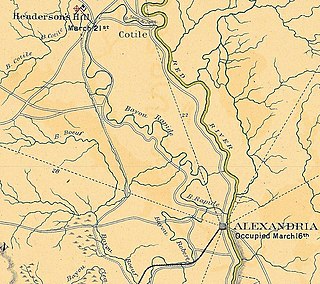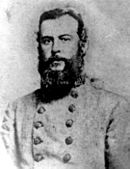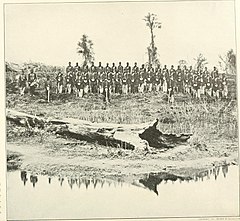Labadieville is a census-designated place (CDP) in Assumption Parish, Louisiana, United States. The population was 1,854 at the 2010 census. It is part of the Pierre Part Micropolitan Statistical Area.

The Battle of Port Gibson was fought between a Union Army commanded by Major General Ulysses S. Grant and a reinforced Confederate States Army division led by Major General John S. Bowen. Though the outnumbered Confederate soldiers fought stubbornly, they were steadily pressed back during the day by Major General John A. McClernand's troops. Bowen eventually conceded the field by withdrawing north toward Vicksburg, Mississippi. The battle occurred near Port Gibson, Mississippi, during the Vicksburg Campaign of the American Civil War.

The Battle of Monett's Ferry or Monett's Bluff saw a Confederate States Army force led by Brigadier General Hamilton P. Bee attempt to block a numerically superior Union Army column that was commanded by Brigadier General William H. Emory during the Red River Campaign of the American Civil War. Confederate commander Major General Richard Taylor set a trap for the retreating army of Major General Nathaniel P. Banks near the junction of the Cane River with the Red River. Taylor assigned Bee's troops to plug up the only outlet from the trap while Taylor's other forces closed in from the rear and sides.

Jean-Jacques-Alfred-Alexandre "Alfred" Mouton was a Confederate general in the American Civil War. Although trained at West Point, he soon resigned his commission to become a civil engineer and then a sugarcane grower, while also serving as a brigadier general in the Louisiana State Militia.
The Battle of Fort Bisland was fought in the American Civil War between Union Major General Nathaniel P. Banks against Confederate Major General Richard Taylor during Banks' operations against the Bayou Teche region in southern Louisiana.

The Battle of Irish Bend, also known as Nerson's Woods or Franklin, was a battle in the American Civil War. It was fought between Union Major General Nathaniel Prentice Banks against Confederate Major General Richard Taylor during Banks's operations against the Bayou Teche region near Franklin, the seat of St. Mary Parish in southern Louisiana.

The Battle of Blair's Landing saw a Confederate cavalry-artillery force commanded by Brigadier General Tom Green attack several Union gunboats led by Rear Admiral David Dixon Porter and soldiers in river transports under Brigadier General Thomas Kilby Smith in Red River Parish, Louisiana. Green's force attempted but failed to stop the retreat of Porter's and Smith's forces downstream in an action that was part of the Red River Campaign of the American Civil War. The only significant casualty during the fighting was Green, who was killed by an artillery round.

The Battle of Yellow Bayou, also known as the Battle of Norwood's Plantation, saw Union Army forces led by Brigadier General Joseph A. Mower clash with Confederate States Army troops commanded by Brigadier General John A. Wharton in Avoyelles Parish, Louisiana during the American Civil War. This was the final action of the Red River campaign in which a Union army under Major General Nathaniel P. Banks was repulsed by Confederate forces led by Major General Richard Taylor. The failed Union campaign almost ended in disaster when an accompanying Union fleet led by Rear Admiral David Dixon Porter was trapped at Alexandria, Louisiana, by low water in the Red River. An engineering feat saved the fleet, allowing Banks' army to complete its withdrawal.

The Battle of Kock’s Plantation was a battle fought July 12–13, 1863, in Ascension Parish, Louisiana, during the American Civil War. It was part of a campaign entitled "Taylor's Operations in West Louisiana (1863)." The Confederate States Army victory left them in control of much of the interior of the Acadiana region.
The Second Battle of Donaldsonville was an American Civil War battle took place on June 28, 1863 in Ascension Parish, Louisiana.

The 13th Texas Cavalry Regiment was a unit of mounted volunteers recruited in Texas that fought in the Confederate States Army during the American Civil War. The regiment was enrolled in Confederate service in February 1862 and served exclusively west of the Mississippi River. The unit was later dismounted and became part of the Texas infantry division known as Walker's Greyhounds. The regiment fought at Milliken's Bend in 1863 and Mansfield, Pleasant Hill, and Jenkins' Ferry in 1864. The regiment disbanded in May 1865, but its official surrender date was 2 June 1865.

The 18th Texas Infantry Regiment was a unit of volunteers recruited in Texas that fought in the Confederate States Army during the American Civil War. The regiment was enrolled in Confederate service in May 1862 and always campaigned west of the Mississippi River in the region known as the Trans-Mississippi Department. The unit was assigned to the Texas infantry division known as Walker's Greyhounds. The regiment fought at Milliken's Bend, Richmond (La.), and Bayou Bourbeux in 1863 and Mansfield, Pleasant Hill, and Jenkins' Ferry in 1864. The regiment disbanded in mid-May 1865, but its formal surrender date was 26 May 1865.

The 11th Texas Infantry Regiment was a unit of volunteers recruited in Texas that fought in the Confederate States Army during the American Civil War. The regiment organized in the winter of 1861–1862 and always served west of the Mississippi River in the Trans-Mississippi Department. The unit was assigned to the 2nd Brigade of the Texas infantry division known as Walker's Greyhounds. The regiment fought at Milliken's Bend and Bayou Bourbeux in 1863 and Mansfield, Pleasant Hill, and Jenkins' Ferry in 1864. The regiment disbanded in mid-May 1865, but its formal surrender date was 26 May 1865.

The Battle of Henderson's Hill or Bayou Rapides saw a reinforced Union Army division led by Brigadier General Joseph A. Mower opposed by a regiment of Confederate Army cavalry and attached artillery under Colonel William G. Vincent. That evening, during a rainstorm, Mower sent one infantry brigade on a circuitous march to gain the rear of Vincent's command. The brigade's subsequent attack surprised and captured most of the Confederates. Mower could not exploit his minor victory because the arrival of additional Federal army and naval units was delayed. This clash occurred during the Red River campaign of the American Civil War which saw Major General Nathaniel P. Banks' Union army try to seize Shreveport, Louisiana, from its Confederate defenders led by Lieutenant General Richard Taylor.

1st Texas Field Battery or Edgar's Company was an artillery battery from Texas that served in the Confederate States Army during the American Civil War. The artillery company formed in November 1860, but was not formally taken into Confederate service until April 1861. The unit participated in the disarming and surrender of United States soldiers and property in Texas in early 1861. The battery marched to Arkansas where in 1862 it joined the infantry division known as Walker's Greyhounds. The battery fought at Milliken's Bend and Richmond (La.), shelled a Federal river transport, and campaigned in south Louisiana in late 1863. The 1st Texas Battery was captured at Henderson's Hill in March 1864. The soldiers were later exchanged, and the unit disbanded in 1865 at the end of the conflict.

The 28th Texas Cavalry Regiment was a unit of mounted volunteers recruited in east Texas that fought in the Confederate States Army during the American Civil War. In May 1862, the regiment entered Confederate service and served the entire war west of the Mississippi River in the region known as the Trans-Mississippi Department. The unit was soon dismounted before being assigned to the 2nd Brigade of the all-Texas infantry division known as Walker's Greyhounds. In 1863, the regiment played a secondary role at Milliken's Bend. The regiment fought in three major battles during April 1864, at Mansfield, Pleasant Hill, and Jenkins' Ferry. The Trans-Mississippi Department surrendered on 26 May 1865, but the survivors dispersed to their homes before that date.

The 2nd Louisiana Cavalry Regiment was a unit of mounted volunteers recruited in Louisiana that fought in the Confederate States Army during the American Civil War. Breazeale's Cavalry Battalion was formed in July 1862 and was augmented by five additional companies in September 1862 to form a regiment. It served for the entire war west of the Mississippi River in the Trans-Mississippi Department. The regiment fought at Georgia Landing, Fort Bisland, Irish Bend, and Brashear City in 1863 and Henderson's Hill and Mansfield in 1864. Afterward, the regiment fought in minor skirmishes before the Trans-Mississippi's final surrender on 26 May 1865.

The 1st Louisiana Field Battery was an artillery unit recruited from volunteers in Louisiana that fought in the Confederate States Army during the American Civil War. The battery mustered into Confederate service in October 1861. The unit traveled to Fort Jackson in early 1862 and took part in the defense of Forts Jackson and St. Philip. The soldiers became prisoners when the forts surrendered and the battery reformed at Franklin after their prisoner exchange. The battery fought at Fort Bisland and Irish Bend in 1863. Later in the year the battery engaged Union shipping on the rivers in several actions. In 1864 the battery briefly fought at Mansfield before its commander was killed while engaging Union gunboats in late April. The unit also fought at Mansura and Yellow Bayou. The battery was in Texas when the Trans-Mississippi Department surrendered in May 1865.

The Actions near Alexandria saw a Confederate States Army force commanded by Major General Richard Taylor surround a greatly superior Union Army led by Major General Nathaniel P. Banks and a United States Navy flotilla commanded by Rear Admiral David Dixon Porter at Alexandria, Louisiana. Porter's gunboats were trapped above the double falls in the Red River by low water. Banks' army was compelled to halt its retreat to keep Porter's vessels from being scuttled or from falling into Confederate hands.

Oliver Paul Gooding was an officer in the Union Army during the American Civil War and was brevetted Major General for his war service. He graduated from the United States Military Academy in 1858 and served in the Utah expedition. After the Civil War broke out he was named colonel of an infantry regiment and accompanied the New Orleans expedition in 1862. He led an infantry brigade at Fort Bisland and Port Hudson in 1863. He led a cavalry brigade in the Red River campaign in 1864. After the war he practiced law and wrote two religious books.























